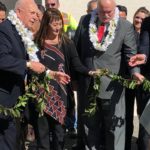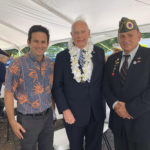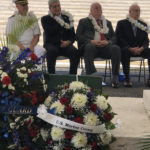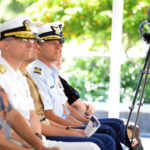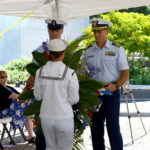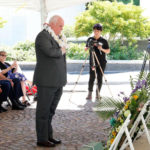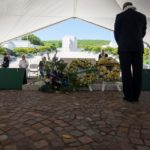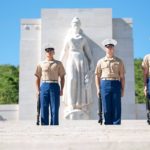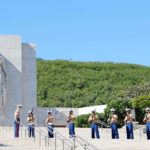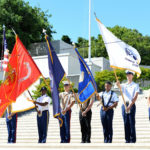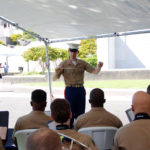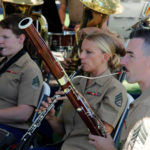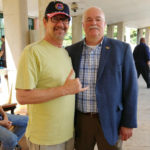The ceremony marked the 75th anniversary of the landings in Betio that initiated the Battle of Tarawa; it was held to memorialize the shared sacrifice of all who fought there and showcase combined commitment to sustaining peace and stability in the Indo-pacific region.
- Photo taken of ABMC Secretary William M. Matz, Tammy Luke, project manager for the U.S. Army Corps of Engineers, VA Under Secretary for Memorial Affairs Randy Reeves and DPAA Director Kelly McKeague officially rededicate the Courts of the Missing.
- Photo taken of ABMC Secretary William M. Matz, Senator Brian Schatz and AmVets Hawaii Barbers Point Post Commander, Dr. Carl Vincenti during the Battle of Tarawa 75th Anniversary Commemoration Ceremony at the National Memorial Cemetery of the Pacific, Honolulu, Hawaii, Nov. 19, 2018. The ceremony was in commemoration of the 75th anniversary of the Battle of Tarawa, in which, during the primary attack, nearly 1,000 U.S. service members lost their lives (U.S. Navy photo by Mass Communication Specialist 2nd Class Seth Coulter)
- Photo taken of DPAA Director Kelly McKeague during the Battle of Tarawa 75th Anniversary Commemoration Ceremony at at the National Memorial Cemetery of the Pacific, Honolulu, Hawaii, Nov. 19, 2018. The ceremony was in commemoration of the 75th anniversary of the Battle of Tarawa, in which, during the primary attack, nearly 1,000 U.S. service members lost their lives (U.S. Navy photo by Mass Communication Specialist 2nd Class Seth Coulter)
- Photo taken of ABMC Secretary William M. Matz, VA Under Secretary for Memorial Affairs Randy Reeves and DPAA Director Kelly McKeague at the National Memorial Cemetery of the Pacific, Honolulu, Hawaii, Nov. 19, 2018. The ceremony was in commemoration of the 75th anniversary of the Battle of Tarawa, in which, during the primary attack, nearly 1,000 U.S. service members lost their lives (U.S. Navy photo by Mass Communication Specialist 2nd Class Seth Coulter)
- Photo taken during the Battle of Tarawa 75th Anniversary Commemoration ceremony at the National Memorial Cemetery of the Pacific, Honolulu, Hawaii, Nov. 19, 2018. The ceremony was in commemoration of the 75th anniversary of the Battle of Tarawa, in which, during the primary attack, nearly 1,000 U.S. service members lost their lives (U.S. Navy photo by Mass Communication Specialist 2nd Class Seth Coulter)
- Photo taken during the Battle of Tarawa 75th Anniversary Commemoration ceremony at the National Memorial Cemetery of the Pacific, Honolulu, Hawaii, Nov. 19, 2018. The ceremony was in commemoration of the 75th anniversary of the Battle of Tarawa, in which, during the primary attack, nearly 1,000 U.S. service members lost their lives (U.S. Navy photo by Mass Communication Specialist 2nd Class Seth Coulter)
- Photo taken during the Battle of Tarawa 75th Anniversary Commemoration ceremony at the National Memorial Cemetery of the Pacific, Honolulu, Hawaii, Nov. 19, 2018. The ceremony was in commemoration of the 75th anniversary of the Battle of Tarawa, in which, during the primary attack, nearly 1,000 U.S. service members lost their lives (U.S. Navy photo by Mass Communication Specialist 2nd Class Seth Coulter)
- Photo taken of Kelly McKeague, Director of the Defense POW/MIA Accounting Agency (DPAA), stands still for a moment of silence after placing a wreath during a ceremony at the National Memorial Cemetery of the Pacific, Honolulu, Hawaii, Nov. 19, 2018. The ceremony was in commemoration of the 75th anniversary of the Battle of Tarawa, in which, during the primary attack, nearly 1,000 U.S. service members lost their lives. (U.S. Navy photo by Mass Communication Specialist 2nd Class Seth Coulter)
- Photo taken during the Battle of Tarawa 75th Anniversary Commemoration ceremony at the National Memorial Cemetery of the Pacific, Honolulu, Hawaii, Nov. 19, 2018. The ceremony was in commemoration of the 75th anniversary of the Battle of Tarawa, in which, during the primary attack, nearly 1,000 U.S. service members lost their lives (U.S. Navy photo by Mass Communication Specialist 2nd Class Seth Coulter)
- U.S. Marines of the 3rd Radio Battalion, prepare to give a rifle salute during a ceremony at the National Memorial Cemetery of the Pacific, Honolulu, Hawaii, Nov. 19, 2018. The ceremony was in commemoration of the 75th anniversary of the Battle of Tarawa, in which, during the primary attack, nearly 1,000 U.S. service members lost their lives (U.S. Navy photo by Mass Communication Specialist 2nd Class Seth Coulter)
- U.S. Marines of the 3rd Radio Battalion, rifle salute during a ceremony at the National Memorial Cemetery of the Pacific, Honolulu, Hawaii, Nov. 19, 2018. The ceremony was in commemoration of the 75th anniversary of the Battle of Tarawa, in which, during the primary attack, nearly 1,000 U.S. service members lost their lives (U.S. Navy photo by Mass Communication Specialist 2nd Class Seth Coulter)
- Photo taken during the Battle of Tarawa 75th Anniversary Commemoration ceremony at the National Memorial Cemetery of the Pacific, Honolulu, Hawaii, Nov. 19, 2018. The ceremony was in commemoration of the 75th anniversary of the Battle of Tarawa, in which, during the primary attack, nearly 1,000 U.S. service members lost their lives (U.S. Navy photo by Mass Communication Specialist 2nd Class Seth Coulter)
- Photo taken during the Battle of Tarawa 75th Anniversary Commemoration ceremony at the National Memorial Cemetery of the Pacific, Honolulu, Hawaii, Nov. 19, 2018. The ceremony was in commemoration of the 75th anniversary of the Battle of Tarawa, in which, during the primary attack, nearly 1,000 U.S. service members lost their lives (U.S. Navy photo by Mass Communication Specialist 2nd Class Seth Coulter)
- Photo taken during the Battle of Tarawa 75th Anniversary Commemoration ceremony at the National Memorial Cemetery of the Pacific, Honolulu, Hawaii, Nov. 19, 2018. The ceremony was in commemoration of the 75th anniversary of the Battle of Tarawa, in which, during the primary attack, nearly 1,000 U.S. service members lost their lives (U.S. Navy photo by Mass Communication Specialist 2nd Class Seth Coulter)
- Alexandra Bonnyman, daughter of Medal of Honor recipient, U.S. Marine 1st Lt. Alexander Bonnyman Jr., places an American Battle Monuments Commission (ABMC) rosette next to her father’s name during a ceremony at the National Memorial Cemetery of the Pacific, Honolulu, Hawaii, Nov. 19, 2018. The ceremony was in commemoration of the 75th anniversary of the Battle of Tarawa, in which, during the primary attack, nearly 1,000 U.S. service members lost their lives. (U.S. Navy photo by Mass Communication Specialist 2nd Class Seth Coulter)
The Battle of Tarawa was One of the Bloodiest Battles in the Pacific Theater of WWII
This was the wake of a series of battles within the American offensive island-hopping campaign, and undoubtedly, one of the bloodiest battles of the Pacific war. Tarawa would be the first time in World War II (WWII) that the United States Marine Corps would face significant opposition from the Japanese. In the span of just 76 hours, the Marines suffered casualties similar to that of the Guadalcanal Campaign, which took place over the span of six months.
In November 1943, as fighting raged, Japanese Admiral Keiji Shibasaki, commander of the Japanese forces defending the Gilbert Islands, was certain that his soldiers would make the invasion of Tarawa more difficult than the Americans had anticipated. U.S. military had sights on conquering the Gilbert and Marianas Islands, paving the way for American troops and allies to advance to Japan.
History records Shibasaki’s confidence in his forces as he purportedly boasted that it would take the U.S. military “one million men and one hundred years” to conquer Tarawa. His forces waged war against more than 35,000 American troops, both U.S. Marines and soldiers. Close to 18,000 Marines from 2nd Marine Division began the assault of the island of Betio in the Tarawa Atoll of Gilbert Islands.
Despite these numbers, both sides endured heavy losses. Only 17 of the 4,500 Japanese defenders survived and surrender. Close to 1,000 Marines were killed in action, as others later died from their wounds. Nearly 2,000 Marines were wounded in action and over one hundred of these Americans never repatriated until recent years.
If they were paving the way to Japan, it would be a long road to Tokyo.
Today, Nov. 20, 2018 marks the 75th anniversary of the start of the Battle of Tarawa, which was part of Operation Galvanic. It marks one of the bloodiest battles of WWII.
Upon arrival, many of the landing craft failed to clear the coral reefs and were forced to try to wade ashore under intense fire. As they were met by enemy fire, only a small number made it to shore. In chest-deep water, those that made it were exhausted, with much of their electrical equipment flooded beyond repair. With resilience and courage, the Marines continued to fight and in 76 hours, not “one hundred years,” the island was declared secure on Nov. 23, 1943.
Despite the sorrow and despair that comes in remembering great loss, 1st Marine Aircraft Wing (1st MAW) and 2d MARDIV commemorated the 75th Anniversary of the Battle of Tarawa with the people of Tarawa, Kiribati. Marines and Sailors from 1st MAW and 2nd MARDIV attended the ceremony. The 75th anniversary ceremony and the repatriation ceremony focused on the courage, service and sacrifice of U.S. service members during the bloody 76-hour Battle of Tarawa.
Through the years, 75 years after a tumultuous past, the U.S. and Japanese forces have forged a close friendship, partnership and alliance that contributes to regional peace and stability. In addition, the ceremony highlighted the friendship and camaraderie between the United States and the people of Tarawa. With strength in U.S. military partnerships since 1943, our Indo-Pacific allies, partners and friends can focus on continued importance of regional security and enduring peace in this region.
Many lessons were learned in the Battle of Tarawa, but more importantly we remain indebted to the heroes of this battle and all of the WWII Pacific Theater veterans. Their service paved the way for a stable post-WWII international order in the region. The 75th commemoration is a tribute to the warriors that represent the resilience and resolve of a generation that endured incredible sacrifices, changing America, Kiribati, Japan and the Gilbert islands forever.

